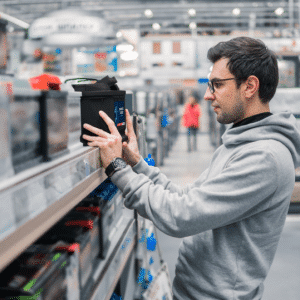In this article, Dan Autey, Executive Vice President of Commercial, shares his thoughts on the changing battery needs in the automotive aftermarket and the growth of EFB.
1. What is the current state of the automotive aftermarket?
More than 286 million vehicles are in operation in the U.S. Almost 40 percent of those vehicles are over 12 years old. This is the sixth straight year that the average age of U.S. vehicles has increased.
Several factors contribute to consumers holding onto vehicles longer. Supply constraints mean low levels of new vehicle inventory. Then, rising interest rates and inflation reduced consumer demand.

Dan Autey
The “sweet spot” for the automotive aftermarket is considered vehicles between 6-14 years. Industry analysts expect vehicles older than six years to account for more than 74 percent of cars on the road in 2028. This is a positive trend for the automotive aftermarket.
2. How have battery needs changed over the years?
Today’s vehicles are more sophisticated than ever. On average, you’ll find anywhere from 1,000 to 3,000 semiconductor chips in a modern automobile, used in a wide range of features such as adaptive cruise control, lane-keeping assist, GPS navigation and smartphone connectivity options.
Automakers have also improved emissions and fuel economy with the utilization of a wide array of new technologies, including start-stop functionality. Start-stop technology can eliminate nearly 10 million tons of emissions each year in the U.S. alone, and that number is growing as the market share of start-stop enabled vehicles increases. Approximately 65 percent of new vehicles produced in model year 2022 included start-stop technology.
Cycling lead batteries are specifically designed to withstand the increased electrical demands of today’s vehicles. These batteries enable the vehicle’s motor or engine to turn off when the driver is stopped, while continuing to operate all vehicle accessories, and then turn back on seamlessly when the driver takes their foot off the brake.
Most modern vehicles come equipped with Absorbed Glass Mat (AGM) batteries. They have previously been the only option to power start-stop vehicles manufactured in the U.S.
However, Enhanced Flooded Batteries (EFB) are gaining popularity with car manufacturers, providing an alternative to AGM for under-the-hood applications. Forecasts show that total battery shipments of EFB in the North American market will grow, from 6.6 percent in 2024 to 10.0 percent in 2026. Nearly 30 percent of the new start-stop vehicles sold in the U.S. come equipped with an EFB.
3. What is the difference between AGM and EFB?
An EFB is a flooded lead battery with enhanced cycling capability and charge recovery compared to standard flooded starter batteries. EFB batteries are designed to meet the standards for SLI batteries, plus the additional requirements for vehicles with the capability to automatically switch off the engine during vehicle operation while in a standstill or moving (start-stop technology), as well as the capability to recover braking energy or energy from other sources.
AGM batteries are constructed differently than other vehicle batteries. Their electrolyte is suspended in a series of fiberglass separators that sit between the battery’s plates. Due to this design, AGM batteries are completely sealed, making them leakproof and maintenance-free. They also have a lower internal resistance, giving them a higher voltage output and a shorter charging time.
4. What should the consumer consider when looking for a replacement battery?
In the past 10 years, we have seen a 30 percent increase in cycling failures, due to the additional computerization in today’s vehicles. New battery technologies, such as EFB and AGM, have been developed to meet these needs. There are several factors to be considered when selecting a replacement battery:
Factory-installed equipment – First, and most important, take note of the type of battery installed by the manufacturer. Some modern vehicles come standard with AGM, while others have an EFB. Many cars, however, still have a standard flooded battery under the hood.
An AGM or EFB may be a suitable upgrade replacement for a standard flooded battery. Replacing an AGM or EFB with a standard type may result in reduced performance or battery life.
Environment – Where you live plays an important part in battery life. Temperatures have reached record highs on the west coast and in the southwest United States. Warmer climates translate to higher under-hood temperatures. EFBs are proven to have a higher heat tolerance than AGM batteries due to free-flowing electrolyte.
Traffic conditions – How you drive can also take its toll on battery performance. Short trips don’t allow the alternator enough time to fully recharge the battery. Each time the battery is not recharged to the full state of charge, the harder it is for the battery to start the vehicle the next time.
EFBs have been shown to have a dynamic charge acceptance rate two times higher than a standard flooded battery design. This allows a faster return to a higher state of charge after deeper cycling.
5. The Environmental Protection Agency (EPA) says more than half of all new cars must be EVs or hybrids by 2032 to meet emissions standards. What does that mean for lead batteries?
The automotive industry could meet EPA limits if 56 percent of new vehicle sales are electric and at least 13 percent plug-in hybrids or other partially electric cars. But EV sales represent only 7 percent of new vehicles sold. This number is up from previous years, but consumers have concerns, such as charging infrastructure, battery charge time and cold weather performance.
The EPA rule also references more efficient gasoline-powered cars that get more miles to the gallon. Start-stop technology is a design feature that improves fuel efficiency and reduces greenhouse gas emissions. Over 30 million vehicles in the U.S. have this feature. The traditional internal combustion engine is not likely to be displaced soon.
In addition, most EVs and hybrids still rely on a 12-volt auxiliary lead battery. This lead battery powers the low-voltage electronics, such as interior lights, alarm systems, infotainment systems, keyless entry and more. Because these systems constantly drain the battery, it’s more economical to use a 12-volt battery rather than the costly lithium battery.
6. How sustainable are lead batteries?
The circular economy of lead batteries is the model for sustainability. The recycling rate of lead batteries in the U.S. is nearly 100 percent, resulting in a stable stream of lead and plastic for future battery manufacturing. This keeps more than 160 million lead batteries out of landfills annually. By comparison, the recycling rate for aluminum cans is 50 percent and only 29 percent for plastic bottles.
A new lead battery produced in the U.S. is typically comprised of more than 80 percent recycled raw materials. U.S. battery manufacturers source about 83 percent of the needed lead from domestic lead battery recycling. In addition, over 90 percent of batteries sold in the U.S. are manufactured domestically, making lead batteries a readily available energy storage solution for consumers and commercial applications.







